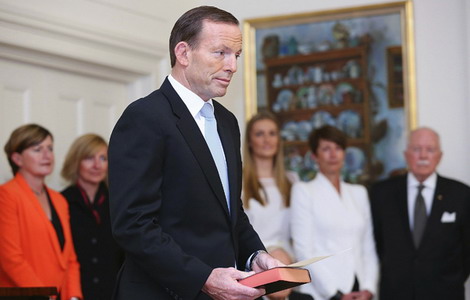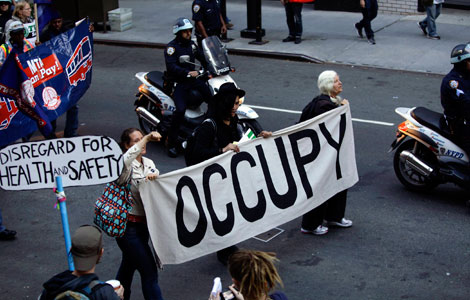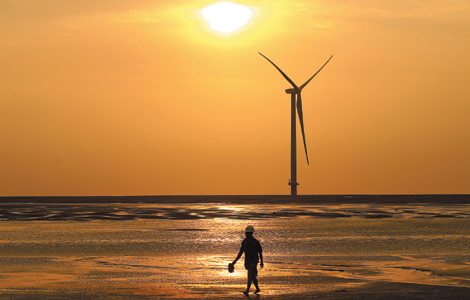Fed surprise: No pullback in bond purchases
Updated: 2013-09-19 16:04
(Agencies)
|
||||||||
Next year's economic growth will be a barely healthy 3 percent, the Fed predicts. The Fed's policymakers expect the unemployment rate to fall to between 7.1 percent and 7.3 percent by the end of 2013, slightly below its June forecast of 7.2 percent to 7.3 percent.
It predicts that unemployment will fall as low as 6.4 percent next year, down from 6.5 percent in its June forecast. In its statement, the Fed noted that rising mortgage rates and government spending cuts are restraining growth.
It repeated its plan to keep its key short-term rate near zero at least until unemployment falls to 6.5 percent from the current 7.3 percent. The Fed's short-term rate indirectly affects many consumer and business loans.
"We're in a slow-growth economy with high unemployment and low inflation,'' said Greg McBride, senior financial analyst at Bankrate.com.
"There's no specific catalyst for the Fed to remove stimulus.'' David Robin, an interest rate strategist at Newedge LLC, said Fed policymakers were surprised by how fast rates rose after they raised the possibility of scaling back the bond purchases.
They likely worried that rates would rise even more, and jeopardize the economy, if they reduced the bond-buying. Bernanke said the Fed is concerned that looming fights between Congress and the White House over the budget and taxes could slow the economy.
Unless Congress can agree to fund the government past Oct. 1, a government shutdown will occur. The government is also expected to reach its borrowing limit next month. Unless Congress agrees to raise the limit, the government won't be able to pay all its bills.
"This is one of the risks we are looking at,'' Bernanke said. The Fed's policy statement was approved on a 9-1 vote. Esther George, president of the Federal Reserve Bank of Kansas City, dissented for the sixth time this year. She repeated her concerns that the bond purchases could fuel high inflation and financial instability.
The decision to maintain its stimulus follows reports of sluggish economic growth. Employers slowed hiring this summer, and consumers spent more cautiously. Super-low rates are credited with helping fuel a housing comeback, support economic growth, drive stocks to record highs and restore the wealth of many Americans.
John Canally, investment strategist at LPL Financial, suggested that financial markets had overreacted in anticipation of reduced bond purchases. Higher rates "started to impact the real economy, and (the Fed) got a little bit concerned.''
Economists suggested that the Fed will still eventually scale back its bond buying, perhaps before year's end. "Tapering will come sooner rather than later, assuming that the economy cooperates,'' Sung Won Sohn, an economist at California State University Channel Islands, wrote in a research report.
"The economy is steady, though not strong, and is moving in the right direction The unemployment rate is now 7.3 percent, the lowest since 2008.
Yet the rate has dropped in large part because many people have stopped looking for work and are no longer counted as unemployed _ not because hiring has accelerated. Inflation is running below the Fed's 2 percent target.
The Fed meeting took place at a time of uncertainty about who will succeed Bernanke when his term ends in January. On Sunday, Lawrence Summers, who was considered the leading candidate, withdrew from consideration.
Summers' withdrawal followed growing resistance from critics. His exit has opened the door for his chief rival, Janet Yellen, the Fed's vice chair. If chosen by President Barack Obama and confirmed by the Senate, Yellen would become the first woman to lead the Fed.

 Tapestry of Chinese culture and a Harvard teen's feeling
Tapestry of Chinese culture and a Harvard teen's feeling
 A simple but pure festival tradition
A simple but pure festival tradition
 Beijing's rabbit god returns
Beijing's rabbit god returns
 It's the real deal: Class explains genuine vs fake
It's the real deal: Class explains genuine vs fake
 An eclipse of the mooncake
An eclipse of the mooncake
 Australia's new government sworn in
Australia's new government sworn in
 Occupy Wall Street marks its second anniversary
Occupy Wall Street marks its second anniversary
 Learning China through its food
Learning China through its food
Most Viewed
Editor's Picks

|

|

|

|

|

|
Today's Top News
Fed surprise: No pullback in bond purchases
Sanctions no solution to DPRK issue
A new tool to measure greenhouse gas is out
Gunman's mother apologizes
Godiva's chocolate mooncakes find favor in US
CNOOC makes trading debut in Toronto
China asked to help end Syrian conflict
Trade treaties trade spotlight
US Weekly

|

|





